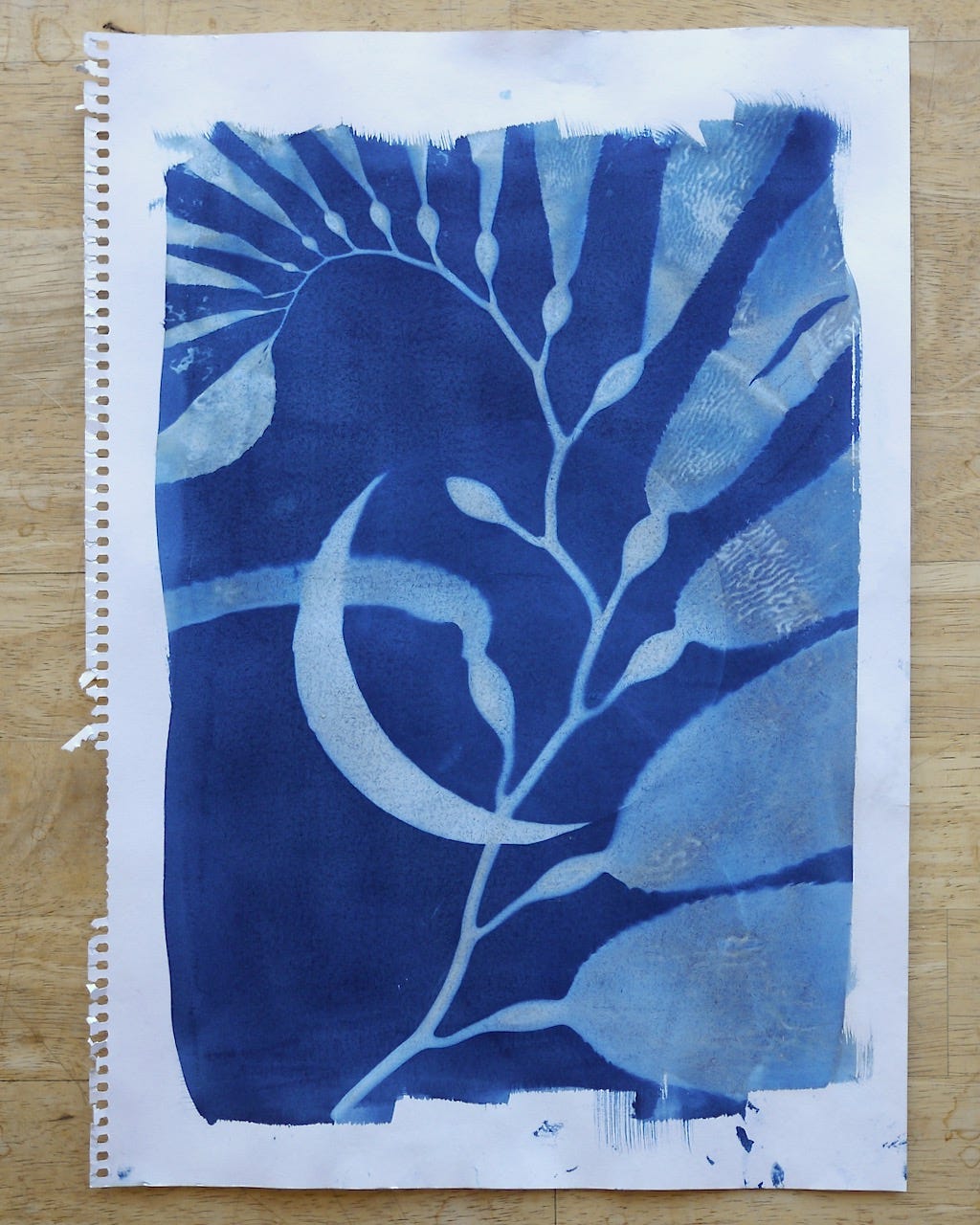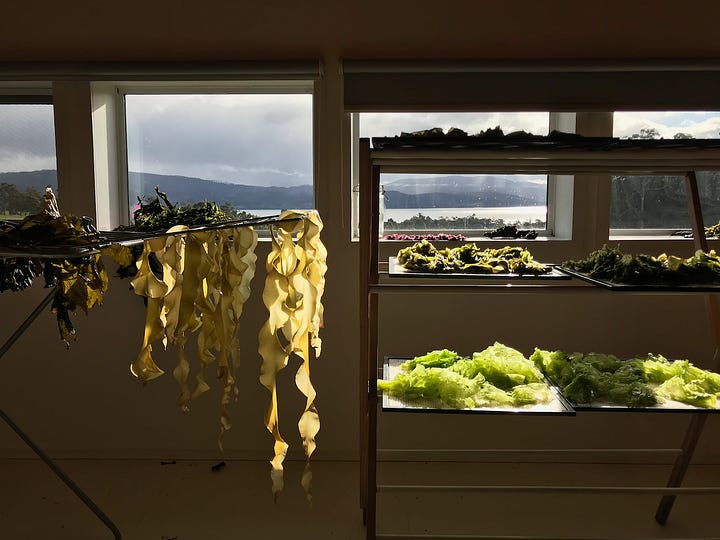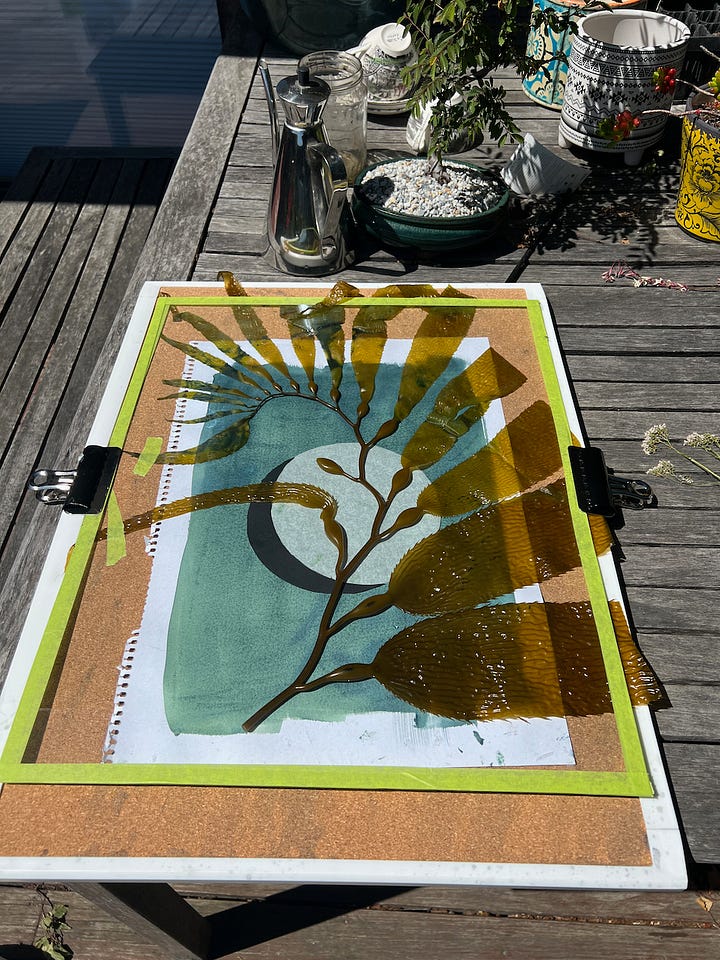Giant kelp, waxing crescent
The sun leads the waxing moon across the sky... and now we both know.

So it appears I’m kicking off this garden-ish journal not actually in the garden, but down on a rockshelf at one end of Randalls Bay, instead.
What defines the boundaries of a garden, though? I come to this rockshelf often - to sit and to think, to watch the kelp in the waves, and to gather wrack (washed up seaweed) from the nearby beach on my way home - for our kitchen (if there’s some fresh bits) and for the garden, always.
Around and around go the nutrient cycles - concentrated into seaweed, then carted from the ocean uphill and slightly inland to our garden, where this seaweed will compost and distribute it’s goodness into our garden soil, then our carrots, then our bodies.
In time, these minerals will make their way out of our bodies and soil and back downhill, filtering through the watershed, the soils, the local rivulet - back out to the ocean, to be taken up and used again, by lifeforms including but not limited to seaweed. And back around we go.
Above - the remains of a rakali’s breakfast (crab bits), and the kelp…
Swaying and breathing back and forth in the slow surges, always just out of reach off the rock shelf. Giant kelp (macrocystis angustifolia) was one of the reasons I was excited to move to this part of the world, 5 years ago.
The macrocystis Giant kelp grows in many places around the world, but the type we live beside in lutruwita is macrocystis angustifolia. It’s famed as one of the fastest growing seaweeds, at up to 60cm a day. Lots of experiments with kelp farming along our coastline are starting to use the species.
In the ‘channel country’ beside this bay, giant kelp used to be everywhere, in masses sufficient to be called ‘kelp reefs’. Some were removed for ease of shipping over the last few generations, some has disappeared because of acidifying ocean water, and now there are only a few precious patches left of it growing wild. Including in this bay.
It’s not a low-tide kelp, as such. It sits juuuuust out of reach, off the rockshelf, anchored by its holdfast in deeper water. Snorkelling between the fronds is forest-like and wonderful. From above the ocean surface, you can see just the few top fronds and air bladders, gathered together in unassuming patches here and there. Giant kelp doesn’t look like much, unless you get in there with it. But from beneath, it is majestic.
Like all Australian kelps, giant kelp is edible, but it’s not considered a favourite eating seaweed by many folks. We gather beach-cast, fresh-ish pieces and use it like kombu - dried and added to soups.


When I first met giant kelp, when we moved here, I got all excited and tried to make noodles out of it (like you can from sugar kelp, which grows in the northern hemisphere). No luck though - it’s a different texture, taste, structure, and entirely it’s own seaweed. So now we just dry it and add to soups, stews and rice. Delicious.
Occasionally, I’ll find some giant kelp washed up on the beach, and that is always a good day. It’s fronds are some of the most beautiful patterns I’ve ever seen.
Like any seaweed, if it’s not fresh (you can tell by the slime level, and also the ‘I’m clearly already becoming compost’ vibes) then it’s into the garden bucket. As with any wild food, always check what the story is with gathering that species in that place first (here’s the AU regs on seaweed, for example) - and learn about the principles of the honorable harvest before you dive in.
The moon today is a waxing crescent. As I’m learning about the moon, I’m loving the process of learning where in the sky it will be (at least vaguely) at what time of day, and organising my evening accordingly, when I can.
I know now that the sun ‘leads the waxing moon’ across the sky - so you’ll see the waxing crescent near sunset in the west, following the sun down beneath the horizon. I love knowing this. Why didn’t I grow up knowing this? Because of a million reasons. Time to undo that un-knowing, a little.
Anyway - now that I have a sense of where the new-ish moon will be, last night Nick and I scooted off after dinner to a west-facing beach at sunset - to watch the new crescent moon follow the setting sun down over the horizon.
The moon was doing their beautiful thing as it set over the hills on the other side of the Huon river, and the air was clear enough that we could see the ‘earthshine’. Which turns out to literally be the Earth (the bit that’s till in daytime after our sunset) reflecting sunlight back onto the surface of the moon. The effect is being able to see-but-not-see the rest of the moon’s face, with the crescent brightly lit.
With a small thermos of tea and some minty chocolate, it was a beautiful way to watch the night come down. Then we drove home over the hill, ever so slowly in the dark, and saw our first Tassie Devil, black, huge and hurrying - nipping home across the road. So very special.




This morning I got up early and worked with giant kelp as the first Lunistice herbarium print subject (yay), with some cyanotype paper I made a few days ago.
I have been playing with plants and prints for precisely one week so far, and there is an ocean to learn - from how different species react and work with printing techniques, to what inks to use, to which paper, to how the heck to get the moon in there. I am equal parts intimidated, amazed, and in love.
And unlike my normal self, part of this project is travelling alongside the practice, and the process, and showing what is being learned, as I go. I’ve never been very good at sharing work or projects until they are Finished and look Very Professional. So here goes. Scary new thing. Breathe. Any feedback welcome, but do be gentle, for the first while at least?
The gorgeousness of this kelp and it’s delicate life-way squeezed my heart. It was excellent to work with it (thank you, kelp) and now the fresh piece is hanging up on the washing line to dry, ready to be snipped into pieces and added to our kombu jar.
The other, older piece gave different effects with it’s gooey ‘I’m already changing form’ breakdown, so that piece is now in the compost, where it can transform and prepare to live other lives when it’s added to the vegetable garden in a few months.
May the swaying kelp be a part of your nighttime dreaming x






Ohhhh so loved listening to your voice as I followed your words Kirsten! I’m so excited by this journal sharing space of yours ♥️ thank you! I am also deep in kelp dreaming right now having just made my first kelp print… learning more about kelp magic through your share was inspiring. I LOVE that you are playing with cyanotyoes! They are so fun! And you can see the kelp patterns!!! Eeeeee!
I am going to love following your journey here 🌑 🌙 🧜♀️
Glorious!